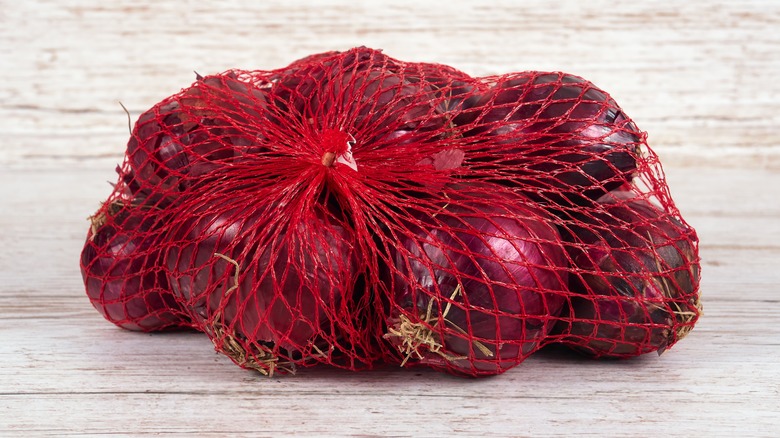Which U.S. State Produces The Most Onions?
It's rather tricky to cut an onion without crying, and the taste of an onion is perhaps best described as sharp. Even so, it's an incredibly popular vegetable in the United States, and there's a compelling reason why. As BBC Good Food explains, this veggie can add complexity to otherwise plain foods. Also, cooking onions for a long time can actually make them sweet. Plus, there are several different varieties, like red, yellow, white, and sweet onions, so chefs have plenty of options.
The United States is not the first nation to recognize this potential, though, and onions aren't even native to the States, per Aggie Horticulture. Instead, they hail from Central Asia. Still, onions' deliciousness meant they were gradually carried farther west until they eventually reached North America's West Coast, and it's there that an agricultural powerhouse took up the mantle of growing the largest number of U.S. onions.
The West Coast is the best coast for U.S. onions
The Golden State can cry tears of joy because California is the top producer of onions in the United States of America. As recently as 2021, USDA data showed that California led the states in general when it comes to total onion production, as well as specifically with area cultivated, utilized production, and the value of utilized production, during recent years. In 2020, for example, California planted and harvested more than 100,000 acres, and the total value of the crop was estimated to be nearly $900 million.
California is an enormous state, of course, which gives it somewhat of a leg up in this regard. However, its geographic variability also means that certain types of onions must be grown in particular Californian regions for best results. As explained by UC Davis, this primarily comes into play concerning what sort of day length each variety benefits the most from. For example, the Southern California desert valleys plant short-day varieties in the fall and then harvest in late spring. Meanwhile, the farmers in the Tulelake basin in the north plant long-day varieties in the spring and harvest in the fall. Central regions of California tend to plant intermediate-day varieties in the fall and then harvest in the summer. This dynamic makes the Golden State the exclusive grower of both spring- and summer-harvested U.S. onions — an impressive feat. Will such plentiful growth really last forever, though?
Can California overcome its obstacles?
A look at history indicates California's onion industry is going to keep expanding. Per UC Davis, it's not certain when California started growing onions, but onion production was first recorded there in the 19th century. In the early 20th century, the United States started relying heavily on the Golden State for its onion-seed needs. Then, the 1930s brought about a healthy dehydrated-onion market there, as well. By the time the 21st century rolled around, acreage had started to level out, but yield continues to increase, presumably due to scientific advances.
However, there are challenges that pose a threat to the California onion industry. The pandemic, of course, created a whole host of labor and supply chain issues, as mentioned by the California Department of Food & Agriculture. There are also ongoing issues of irregular weather patterns and natural disasters like wildfires, according to the USDA. Both of those issues go hand-in-hand with California being too dry, and the Golden State is indeed in a drought. Even when it occasionally rains in force there, the state simply isn't well equipped to collect and store that water for when farmers need it most (via the Washington Post). Without enough water, there won't be enough Californian onions to go around. These kinds of problems aren't unique to the Golden State, however, so even if California takes a hit, it could remain the champion of U.S. onion production regardless.


